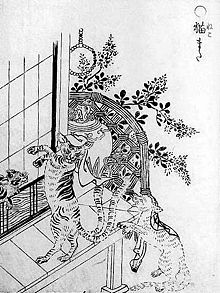This is an old revision of this page, as edited by 60.54.127.68 (talk) at 17:21, 25 February 2013. The present address (URL) is a permanent link to this revision, which may differ significantly from the current revision.
Revision as of 17:21, 25 February 2013 by 60.54.127.68 (talk)(diff) ← Previous revision | Latest revision (diff) | Newer revision → (diff)| This article includes a list of references, related reading, or external links, but its sources remain unclear because it lacks inline citations. Please help improve this article by introducing more precise citations. (December 2012) (Learn how and when to remove this message) |

Nekomata (jap. 猫股 or 猫又; meaning ‘forked cat’) is the name of a being from Japanese mythology. It is said to be a slightly more powerful form of a bakeneko (a high ranked cat-demon).
Description
A nekomata is an old bakeneko with a tail that has partially split in two (distinguishable from having two tails, since they join before they reach the body). The literal translation of nekomata is "forked cat." Again, these have become quite big - some are said to be about one and a half meters long (minus the bifurcated tail) - and walk comfortably upon their hind paws. Cats are often associated with death in Japanese, and this particular spirit is often blamed. Far darker and malevolent than most bakeneko, the nekomata is said to have powers of necromancy, and upon raising the dead, will control them with ritual-like dances - gesturing with paw and tail. These yokai are associated with strange fires and other unexplainable occurrences. The older, and the more badly treated a cat has been before its transformation, the more power the nekomata is said to have. To gain revenge against those who have wronged it, the spirit may haunt humans with visitations from their dead relatives. Like bakeneko, some tales state how these demons have taken on human appearance - but have usually appeared as older women, behaving badly in public and bringing gloom and malevolence wherever they travelled. Sometimes the tails of kittens were cut off as a precaution as it was thought that if its tail couldn't fork they couldn't become one.
Traditions
First stories about alleged encounters with nekomata occur during the early 17th century of Japan. In the book Yamato Kaiiki (大和怪異記, engl. "Mysterious stories from Japan"), written by an unknown author in 1708, a story speaks about a haunted house of a rich samurai. The inhabitants of this house witness several poltergeist-activities and the samurai invites countless shamans, priests and evokers in attempt to make the happenings come to an end. But none of them is able to find the source of the terror. One day one of the most loyal servants observe the very old cat of his master carrying a shikigami with the imprinted name of his lord in its mouth. Immediately the servant fires a sacred arrow, hitting the cat in its head. When the cat is lying dead on the floor, all inhabitants can see that the cat has two tails and therefore has been a nekomata. With the death of the demon-cat the poltergeist-activities end. Similar eerie stories about encounters with nekomata appear in books such as Taihei Hyakumonogatari (太平百物語, engl. "Collection of 100 fairy tales"), written by Yusuke (祐佐, or Yūsa) in 1723 and in the book Rōō Chabanashi (老媼茶話, "Tea-time gossip of old ladies"), written by Misaka Daiyata (三坂大彌) in 1742.
Nekomata in modern subculture
Nekomata are popular motifs in manga and anime today. A well known fictitious Nekomata of modern times is "Kirara" from the novel and anime series InuYasha, written by Takahashi Rumiko. Kirara appears there as a cuddly little kitten with two tails when calm, but she rapidly morphs into a giant, flying saber-toothed tiger, when provoked or whenever her mistress 'Sango' orders the cat to do so.
A Nekomata is also seen in Ao No Exorcist with the character Kuro aka 'Blackie'. It is known for being a docile, sad cat who is waiting for his master to return. However, hearing the guards talk about his master's death, he becomes furious, unable to believe their words. He turns into his demon form, causing chaos until his master's son, Rin, settles him down. Chen, a character in the game series Touhou is also a Nekomata, under the control of another demon, Ran Yakumo.
See also
Sources
- Patrick Drazen: A Gathering of Spirits: Japan's Ghost Story Tradition: from Folklore and Kabuki to Anime and Manga. iUniverse, New York 2011, ISBN 1-4620-2942-6, page 114.
- Elli Kohen: World history and myths of cats. Edwin Mellen Press, Lewiston 2003, ISBN 0-7734-6778-5, page 48–51.
- Carl Van Vechten: The Tiger In The House. Kessinger Publishing, Whitefish 2004 (Reprint), ISBN 1-4179-6744-7, page 96.
External links
- web-informations about Nekomata at obakemono.com (English)
- Nekomata – The Split-Tailed Cat at hyakumonogatari.com(English)